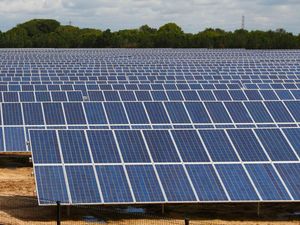100-acre solar farm planned close to Shropshire and Staffordshire border
A huge solar farm stretching over 100 acres could be built close to the Shropshire/Staffordshire border.

Specialist power plant developer, Greentech Projects is planning a solar development of 39 megawatts in the shadow of Lilleshall Hill and Abbey, near Sherrifhales.
It says the effect on the local environment would not be enough to warrant carrying out an Environmental Impact Assessment.
Shropshire Council has to decide whether the 43-hectare agricultural site, between Shifnal and Newport, should be subject to an assessment.
A submission to the council from planning consultant Arcus, says 42 hectacres is the maximum area being considered for the development, with the final design informed by ongoing environmental studies.
"The approach to minimise environmental effects is to avoid impacts in the first instance and where that is not possible then mitigation and compensation may be required within the design," the submission says.
An area of woodland along the south west boundary and also hedgerow and trees, some mature, along parts of its boundaries would, Arcus says, help in filtering and screening views of the development, with all existing woodland, trees and hedgerow retained and enhanced.
The rows of solar panels, known as strings, would be dark, designed to maximise the absorbency of the sun’s rays and minimise solar glare. A 2.4 metre high perimeter fence would go up around the solar panels.
Arcys says an abundance of similar agricultural land in the surrounding area, and the industrial complexes to the south would mean the area would provide space for biodiversity to thrive and ultimately lead to a biodiversity net gain.
"There is the potential for agricultural land use to continue in conjunction with the development once it is operational, in the form of sheep grazing amongst the solar panels," it says.
Fears over the panels leading to glint and glare effects from reflected sunlight, affecting nearby receptors such as car drivers, residential properties and aviation receptors have also been allayed.
"The impact is generally only of concern at dawn and dusk and is limited by the position of the panels relative to the sun. They are designed to absorb maximum daylight to convert it to electricity and therefore have low levels of reflectivity when compared to surfaces such as window glass, water or snow.
"Solar panels are also provided with anti-reflective coating so minimise any such potential reflectivity."
The document says construction noise will be for a minimal time as solar farm construction takes place quickly.
"Given the temporary nature and limited extent of such works, the noise impact from such activities can be controlled by limited working hours maintenance," it says.
"Once up and running visits would occur approximately once per month and involve a small van or 4x4 vehicles."
Shropshire Council is being asked to agree there is no need for an Environmental Impact Assessment.





